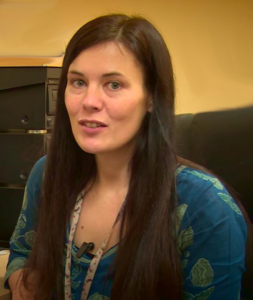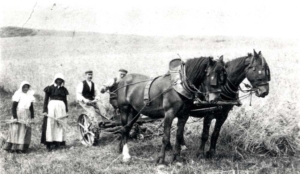 Gura mie mooar ec Nicola Tooms – grateful thanks indeed to Nicola Tooms for giving us an overview of how the Manx Museum embarked on its collection of artefacts associated with the skills which people developed in occupations which were vital to everyday life but which were recognised from quite early on in the 20th century as becoming more niche and marginal in a changing world. It was these objects – hand tools used by saddlers and carpenters, varieties of spades for digging turf and making sod hedges, the wheels and other objects for use with preparing flax and wool – which first brought Nicola to work for Manx National Heritage. Where items had information attached, the paper records were often ripped or worn. Other objects had simply been stored away unrecorded. Nicola’s task was to produce a complete inventory of what there was. However, it meant she had to research into the background of the trades to find out what exactly some of these objects were and what they were called.
Gura mie mooar ec Nicola Tooms – grateful thanks indeed to Nicola Tooms for giving us an overview of how the Manx Museum embarked on its collection of artefacts associated with the skills which people developed in occupations which were vital to everyday life but which were recognised from quite early on in the 20th century as becoming more niche and marginal in a changing world. It was these objects – hand tools used by saddlers and carpenters, varieties of spades for digging turf and making sod hedges, the wheels and other objects for use with preparing flax and wool – which first brought Nicola to work for Manx National Heritage. Where items had information attached, the paper records were often ripped or worn. Other objects had simply been stored away unrecorded. Nicola’s task was to produce a complete inventory of what there was. However, it meant she had to research into the background of the trades to find out what exactly some of these objects were and what they were called.
Nicola explained how the Irish Folklore Commission had been very helpful in training people in the techniques of encouraging people to talk about their way of life, many of them modest in assuming that they were too mundane for anyone to be interested in them. The result is the wonderful store of information in the Folk Life Survey. The Manx Museum, and now Manx National Heritage, has always seen its task as presenting the Island’s way of life, and set out to try to get examples of objects which were once in daily use in association with trades which have either become specialist or are no longer practised, as is the way with peat digging. The importance of turbaries is reflected in the existence in laws from the 1500s which provided for what was described as the Manx spade to be an object of importance which could be bequeathed in a will. However, peat digging is no longer allowed in the Island, so an activity which once formed a vital part of life, going out to dig and later to cart home the fuel which provided heat for the family and for cooking on, has come to an end.
As well as the Manx spade, there was also a distinctive Manx stiff cart in use on farms. Skilled tradesmen needed to be able to turn their hands to provide a range of objects as well as specialist items. One of the items reflects the ingenuity that could be involved as well. With Kneen and Martin seeing examples of mechanical reapers brought to the Island, they set out to make copies of the components shaped from wood and turnips. The took these objects and had them cast at Gellings Foundry and were able to make the Kneen and Martin reaper to make and sell in the Island, rather than having to import machinery. Whilst stories of these machines had been told to collectors of the Folk Life Survey, it was only when Margaret Killip recognised one found in a hedge in Jurby that an example was brought to light. And there it is on display in the Traders of the Lost Arts exhibition, which was curated by Nicola from Manx National Heritage’s collections.
Gura mie mooar ec Nicola Tooms for such a very interesting guide to the exhibition.

